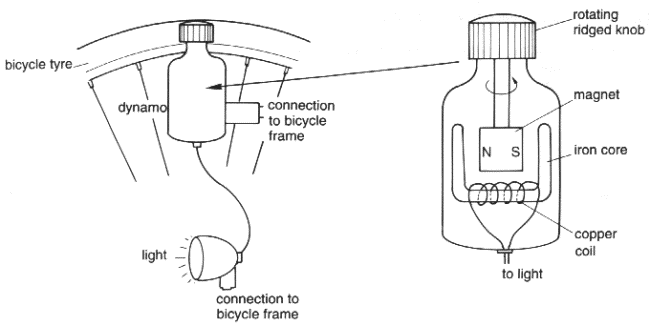
The Energy Recovery System
2014 brought a radical change to formula 1, with regulations limiting the size of the engine and the RPM output to the lowest ever. It was time for a new way to generate power.
F1 teams came up with an advanced solution: The energy recovery system. [1] The power unit now consists of 6 different separate elements:[2]
1. The Internal Combustion Engine (ICE)
2. The Motor Generator Unit-Kinetic (MGU-K)
3. The Motor Generator Unit-Heat (MGU-H)
4. The Energy Store (ES)
5. Turbocharger (TC)
6. The Electronic Control Unit (ECU)
The MGU-K
The MGU-K is a more efficient way of recovering energy that the 2014 version: KERS. [3]
From the Tyres and Friction page, we know that as brakes are applied to slow a vehicle down, kinetic energy is converted to useless heat energy by frictional forces. The F1 engineers have found a way to convert as much of this kinetic energy to electrical energy without losing it all. The way this is done is through a Motor Generator Unit-Kinetic, storing energy in the ES and reusing it for a boost of power.
The main technology that they use is one that his been around for years, and one that you may have attached to your bike at home: a dynamo. As the wheel on the bike turns, it rotates a magnet inside a coil of wire. The changing magnetic field produces a current (electricity) inside the wire which is used to power the light bulb.
[4]
A dynamo on a bike generates around 3 Joules of electrical energy, clearly not enough to win a race.
Now, the issue with a dynamo is that it creates friction which slows down the bike, obviously not what you want in an F1 car, unless you use it to brake. The genius behind the system is that the dynamos are only working when the driver wants to slow down. This means that the Formula 1 car generates extra energy when approaching a corner and the driver brakes, only to use this energy to add an extra boost of power to the wheels when the driver steps on the accelerator as he approaches the straight.
The rules state that a maximum of 2MJ can be saved by the MGU-K per lap. This equates to 16.7 seconds of braking to reach maximum storage. 4MJ can be used by the car to provide an extra boost. This equates to an extra 160 BHP for 33 seconds. To put this into perspective, each lap the car can recover enough energy to talk for 370 hours on your smartphone. [5]
The MGU-H
Even in a commercial car driving at normal speeds, huge amounts of energy is being wasted as heat; from the engine, the exhaust fumes, the brake pads, to name but a few. Now, in normal cars, these energy losses don't matter too much, but when a split second is the difference between winning and losing, every fraction of energy is vital.
In the ICE (internal combustion engine) there are over 750 explosions every second creating exhaust gas temperatures of 1000 degrees celsius. Temperature is a number used to represent the amount of kinetic energy the molecules in a gas have and so the higher the number, the higher the kinetic energy. As the kinetic energy rises, the molecules become more excited and begin to move faster, hitting the edges of their container with greater force. This extra force creates higher pressure. The pressure of exhaust fumes in a formula 1 car is therefore extremely high. [6]
All of this heat energy though, would be wasted if it wasn't for the MGU-H. The hot air is forced out of the ICE and down with immense force and kinetic energy. Placing a turbine in the exhaust pipe allows the F1 teams to harvest this energy.
We have already seen how the exhaust fumes are used by the turbocharger to add extra efficiency to the engine, but here the turbine is being rotated to produce electrical energy. The heat energy from the exhaust fumes is therefore constantly being captured. The electrical energy is mainly sent to the energy store where it can be used at a point when the vehicle needs it most. The electrical energy is then used to power the wheels, like that MGU-K.
Additionally, we briefly saw how the turbocharger experienced 'turbo lag' at low speeds, well here is another amazing trick of the MGU-H. Some of the electrical energy is used to spin the turbocharger, and therefore the compressor can work even when limited exhaust fumes are running through it. This increases the efficiency of the ICE and the power that it can create. [7]
Unlike the MGU-K, the amount of energy that can be converted by the MGU-H is unlimited, the only decision to be made is how and when to use it best.
The ECU
How many things do you think you monitor when you drive a car?
The road ahead? Your speed? The road behind? In all, probably around 4 or 5 things every few seconds. Well the ECU monitors 1000 things a million times a second.
Everything we have seen in the ERS section is maintained and controlled by the ECU. It constantly monitors a combination of the exhaust temperature, the MGU-K, the MGU-H, the turbocharger, brakes and much much more to achieve as much efficiency and power as possible. [8]
The Final Product
ERS is clearly a vital part of the power unit and without it the cars would be significantly slower. To enforce the point, below is a video showing one car using ERS and one without.


